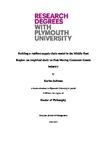Building a resilient supply chain model in the Middle East Region: an empirical study on Fast Moving Consumer Goods industry
| dc.contributor.supervisor | Liu, Shaofeng | |
| dc.contributor.author | Soliman, Karim | |
| dc.contributor.other | Plymouth Business School | en_US |
| dc.date.accessioned | 2017-08-08T12:35:32Z | |
| dc.date.issued | 2017 | |
| dc.identifier | 10386775 | en_US |
| dc.identifier.uri | http://hdl.handle.net/10026.1/9694 | |
| dc.description.abstract |
Fast Moving Consumer Goods (FMCG) supply chains (SCs) are becoming more and more vulnerable to different types of risks due to the increasing complexity of markets, uncertainties, and turbulence, especially in the Middle East Region (MER). The main reason behind this is the political and economic instabilities resulting from the Arab Spring revolutions which affected all SC entities. There is an urgent need to investigate how to build resilient SCs that can help all partners in the chain to proactively identify and sidestep risks, and bounce back more quickly in the case of disruptions. For this reason, this research focuses on the creation of effective SC resilience model that could help companies to avoid SC risks to reduce vulnerability instead of being reactive toward disruptions. A conceptual model for SC resilience has been developed which identified three main constructs of SC resilience: risks, capabilities, and key performance indicators (KPIs). The links between the three constructs have been established. The empirical study has been conducted in two stages. In stage one, semi-structured interviews were conducted to collect data from 30 companies in FMCG SCs operating in the MER. A combination of thematic and comparative analysis has been used to analyse the qualitative data collected from the interviews in order to identify the main themes (types of risks and their causes, capabilities, and relevant KPIs), and to find the relations between themes. In stage 2, Analytical Hierarchy Process (AHP) was used to prioritize and rank the risks, capabilities, and KPIs using pairwise comparisons by taking into account opinions and preferences from SC managers in the FMCG industry in the MER. Preceding the analysis, a second round of structured interviews according to AHP process were conducted with the same 30 companies used in stage one. The thesis adds to the SC resilience literature by empirically explore the main causes of SC vulnerabilities that the FMCG SCs face in the MER and how companies can increase their capabilities to improve the resilience performance of the entire chain. An important contribution of this thesis is the development of the model for SC resilience in FMCG industry in MER context, that provides a useful reference model to assist managers in build a resilient SC, specifically, by identifying the main types of risks and their sources, by defining relevant capabilities that can help anticipate and overcome risks, and by recommending appropriate KPIs that can act as a sensor to market dynamics in the FMCG industry in MER. The model with the matrices (of risks-capabilities-KPIs) developed in this research established the links and interactions among the risks, capabilities, and KPIs which have great potential in guiding decision makers through the SC management (SCM) process, so that more informed decisions can be made and implemented for important risks to be avoided and to create more resilient FMCG SCs. | en_US |
| dc.language.iso | en | |
| dc.publisher | University of Plymouth | |
| dc.subject | Supply Chain Resilience | en_US |
| dc.subject | Supply Chain Risk Management | |
| dc.subject | Analytial Hierarchy Process | |
| dc.subject | Resilience KPIs | |
| dc.subject.classification | PhD | en_US |
| dc.title | Building a resilient supply chain model in the Middle East Region: an empirical study on Fast Moving Consumer Goods industry | en_US |
| dc.type | Thesis | |
| plymouth.version | publishable | en_US |
| dc.identifier.doi | http://dx.doi.org/10.24382/642 | |
| dc.identifier.doi | http://dx.doi.org/10.24382/642 | |
| dc.rights.embargodate | 2018-08-08T12:35:32Z | |
| dc.rights.embargoperiod | 12 months | en_US |
| dc.type.qualification | Doctorate | en_US |
| rioxxterms.version | NA |
Files in this item
This item appears in the following Collection(s)
-
01 Research Theses Main Collection
Research Theses Main


